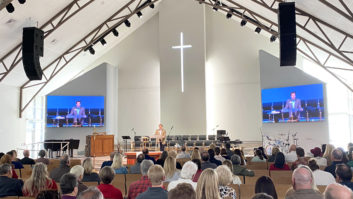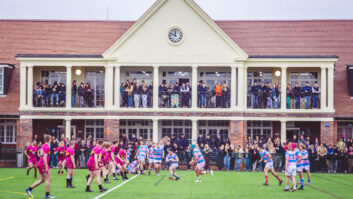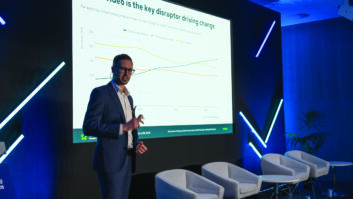In a dramatic turn of events that bears many comparisons with the corporate and education markets, houses of worship (HoW) had to switch from in-person to remote attendance – sometimes literally overnight – as the pandemic arrived in early 2020. Where the AV focus might hitherto have been overwhelmingly on the audio and video inside the church, worship leaders and their staff suddenly had to get to grips with the online world and make sure they had the means to reach their congregants in lockdown.
For this first feature in our two-part look at this exploration of the houses of worship (HoW) market, we focus on video, where expectations have also been rising lately in accordance with the evolving needs of HoW congregations. In part 2, we’ll confirm that the willingness to invest in high-specification audio systems – often comparable to those in lauded concert venues and theatres – is increasingly commonplace.
Few people would contest the assertion that the pandemic was a major impetus to upgrade; all of a sudden, church leaders were faced with a crisis that made in-person attendance essentially impossible. Therefore, acquiring the means to capture and stream worship events in high-quality became top priority – and for many churches, especially outside of the mega-HoW market of the US, this required them to enter an entirely new area of AV.
But whilst that initial reason for change has now faded, it’s clear that HoWs are not keen to relinquish the benefits of being able to reach remote congregants – not least as it gives them a greater in-built flexibility to adjust to demographic and societal changes. In addition, this infrastructure is also being used to generate and deliver other types of content away from regular worship events. All of which means that this market continues to be a rewarding one for AV vendors and service providers as 2024 dawns.
RELIABLE CONSISTENCY
Craig Heffernan, technical sales director EMEA at Blackmagic Design, provides a neat summary of the market’s recent trajectory: “Certainly, during the years of the pandemic, it became evident that our customers in HoW needed advice and guidance on how they could improve and upgrade their live production technologies to quickly move services and events online for live streaming and webcasting; [thereby] ensuring that they provided a constant and reliable support for their communities. We found many adapted whatever video equipment they had into streaming solutions, and often, our products like the ATEM Mini [production switcher] range and Web Presenter [streaming solution], provided that vital link into streaming and social media platforms quickly and effectively.”
Post-pandemic, that ability to support communities “beyond their venues” remains highly prized. It has, says Heffernan, “massive value – especially to those who cannot physically attend, may still be reliable, or are simply too far away. Consequently, there’s a growing demand to enhance earlier makeshift arrangements, with a keen interest in elevating the quality and quantity of online and webcast content.”
Examples of technology enhancements cited by Heffernan include a move towards more advanced studio-level cameras, replacing older webcams and camcorders; and the supplanting of smaller production systems with “larger, full-scale ATEM switchers with greater effects and graphical capability. This is complemented by improvements to audio and lighting, as well as overall production design.” (A live streaming-oriented project for a church in Dallas, and covered by Installation here, is a case in point.)
MULTIFACETED FOCUS
It is likely that this multifaceted focus on AV infrastructure enhancement will continue for some time yet, coupled with the perennial desire for easy-to-use systems that can be operated by personnel who may not necessarily have a technical background.
Heffernan explains: “Enhancing video quality, streamlining production management and enriching the viewing experience have emerged as crucial points in recent discussions with our HoW customers. It’s evident that they aspire to deliver content that’s as clear for their in-person congregations as it is for their online audience, so it is crucial that the quality of their streaming or social media content is of paramount importance as high production values and delivers an engaging viewing experience.
“In addition, we recognise the need for user-friendly systems, understanding that many HoW customers are not experts in AV or video. Live production and webcasting technologies can be intimidating, which is why we prioritise intuitive, fast to learn, and scalable solutions.”
SHEER FLEXIBILITY
Scalability and flexibility are also familiar terms for Vizrt; its content production, management and distribution tools have long been a popular choice for worship venues. Justin Miller, pre-sales consultant at the company, reiterates the point about the pandemic having had an impact on demand: “HoW customers were forced to adapt to the circumstances, so we saw an increased interest in delivering their services to a remote congregation. But from our end, there wasn’t [an impact on related R&D] as we already had the necessary solutions to make that transition possible.”
Underlining his assertion that “the needs are always different [and] the right AV set-up will depend on the size of [HoW] and what they want to achieve”, Miller reveals that an extensive selection of Vizrt video production systems are now finding their way into worship facilities: “We’ve seen many TriCaster 1 Pros and TriCaster Minis getting installed in HoW facilities, which reflects the sheer flexibility of our solutions, as we’re talking about one of our high-end physical video switchers for large spaces all the way to our entry-level lineup for smaller organisations.”
Two recently announced solutions – the TriCaster Mini Go physical switcher and cloud-based video switcher platform TriCaster Now – are also expected to resonate. Of the latter, Miller remarks that it “empowers anyone to connect, produce and stream content from anywhere – all under a convenient and always available on-demand model. This will be of particular interest to HoW clients, as there’re no large upfront costs, no physical hardware, and users always use the latest and greatest version of the product.”
Aside from specific solutions, he pinpoints the management and sustainability of remote connections as being an enduring priority in the worship sector – something that Vizrt has addressed with use of the NDI networking technology originally developed by NewTek (the company which became part of Vizrt in 2019). “Innovating a reliable method for remote signal acquisition is one example of how it’s being done, with NDI Bridge connecting two or more AV networks across public internet for bi-directional contribution and remote administration,” he says.
Remarking that growth “across the APAC” region – as well as in the US – has been significant in recent years, Miller suggests that further improvements in video production and streaming capacity will remain the top tech priority for many worship venues. “Simplifying the remote participation and engagement for the HoW community that counts on live streaming will continue to be a focus for providers,” he remarks. “This spans from live testimony of remote participants being shared on-prem and to other remote guests simultaneously, all the way up to more live interaction options for remote participants.”
PAPAL APPROVAL
Arguably taking a dual-focus on image quality and streamlined production to its highest possible platform is a recent project for Sony, which continued its long-standing partnership with Vatican Media – the official institution within the Vatican responsible for broadcasting the Pope and the Vatican’s activity – by upgrading its broadcast system.
Invited to provide a package delivering the best quality footage with the smallest possible impact on the historic surroundings, Sony supplied multiple Sony HDC-5500 cameras – all connected (via Sony HDCE-100 adaptors) to a fibre network designed by the engineering department of the Vatican’s Dicastery for Communication and linking the cameras to the production control rooms – that can shoot in 4K, HD and HDR, along with Sony PVM-X series monitors situated in the production suite. Rounding out the new inventory, Sony also provided BRC-H800 PTZ cameras, and an FX9 camera to film St. Peter’s Square on a 24/7 basis.
Norbert Paquet, head of live production solutions at Sony Professional Europe, says: “Our long-standing partnership with Vatican Media has enabled us to offer a scalable and reliable system that meets the need for shooting, producing and broadcasting around the world with a low impact on historical environments.”
While relatively few HoWs are likely to possess the scale or requirements of the Vatican, this landmark project shows that even the most historic worship sites want to make the most of the latest AV and broadcast tech. And in an unpredictable world, where geopolitics and climate change are set to throw up even more barriers to in-person attendance, investing in solutions that maintain a high-quality connection with congregations – whatever the circumstances or location – is likely to become even more important.
The second part of our houses of worship special can be found here.







